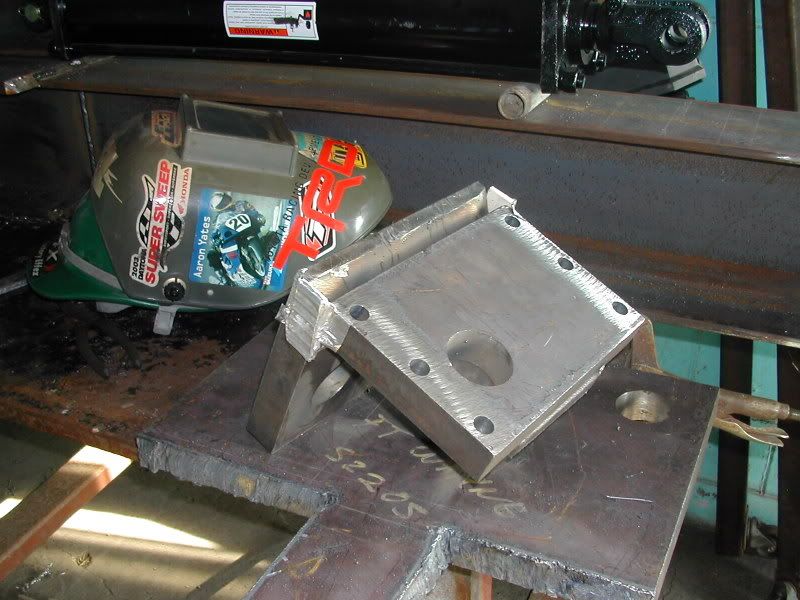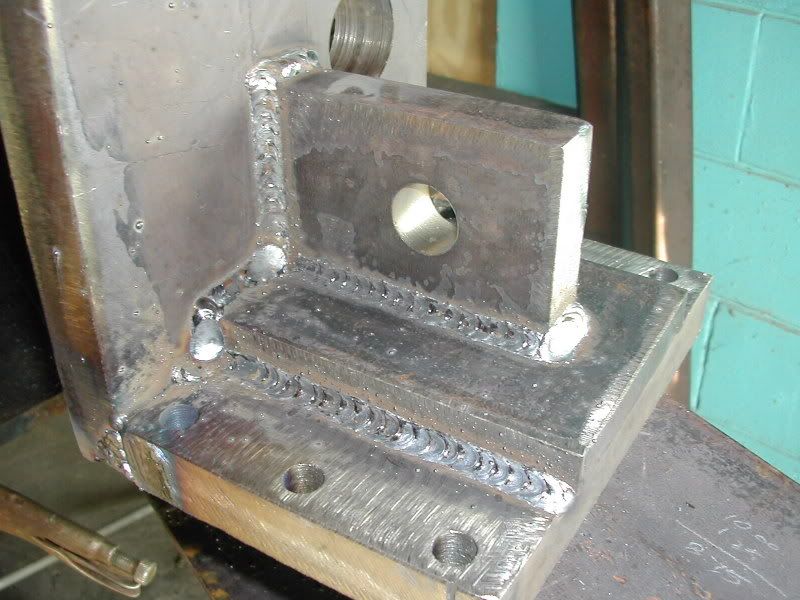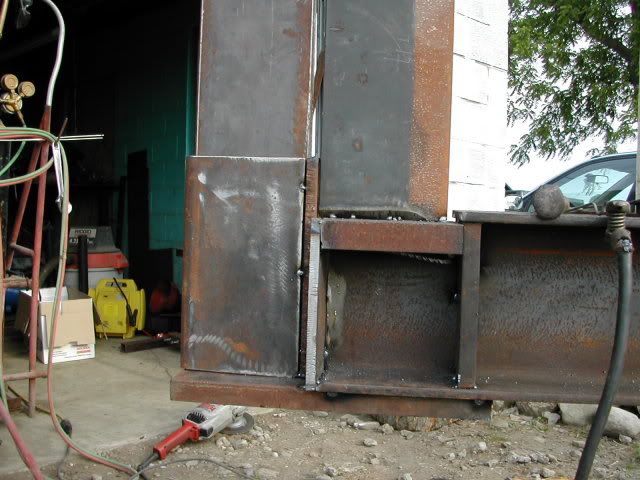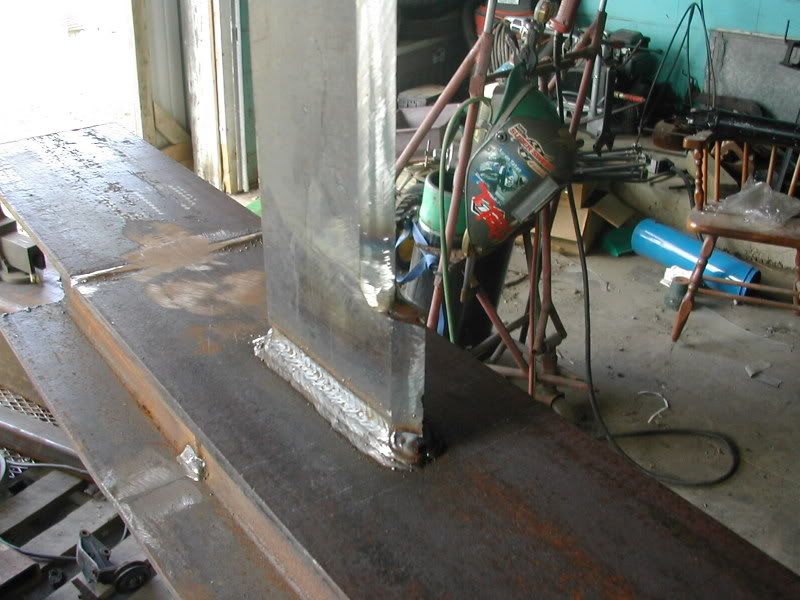In the process of building my own spliter. Soon will be welding the foot plate to the eyebeam. I know the welds need to be strong but how strong? Will this require the use of low hydrogen rods or will a mig with multiple passes get the job done (hot and deep). I have access to a lincoln arc welder that will go up to 225 amp or a larger miller mig. Low hydrogen rods would likely require some one with bigger equipment doing it for me. Any recomendations welcome.
You are using an out of date browser. It may not display this or other websites correctly.
You should upgrade or use an alternative browser.
You should upgrade or use an alternative browser.
Log Spliter Welding
- Thread starter Axlerod74
- Start date

Help Support Arborist Forum:
This site may earn a commission from merchant affiliate
links, including eBay, Amazon, and others.
Assuming end plate is on end of beam. Bevel or good chamfer on the falnges and web. 1/8 or 5/32 7018 is about the toughest weldment out there. Id use a min 5/16 in fillet, multiple passes w/rod. Its DC+ but only runs at 120-150 amps horizontal and a AC/DC 225 amp machine will have the duty cycle to handle it. Im a Unoinon Ironworker and had access to a semi automatic LN25 running flux core NR232 .068 and thats what we use in the field, along w/ 7018. Not a mig pro but Id think it would be too brittle and doubt youll get penetration unless your set up for big wire, no whimpy .035. Or use Lincoln Jet Rod 5/32 7024, its horz. only, run it hot, big long puddle, flux shold peel up. Thats what they use in some big fab shops makin structual beams. Its an AC rod, in case you dont have DC. Theres TONS of tension at the point you want welded.
Last edited:
treklager
ArboristSite Lurker
What material is your wedge made from ?
If its high tensile steel like hardox you will have to pre-heat it otherwice it will break above your weld .
Good welding rods ( in europe) are Baso 100 , Oerlicon special ,or Conarc 49 for a strong weld.
3 layers with a 4mm (160 A DC) rod will mostly be strong enough.
For MIG use baso wire ( do not know US specifications)
If its high tensile steel like hardox you will have to pre-heat it otherwice it will break above your weld .
Good welding rods ( in europe) are Baso 100 , Oerlicon special ,or Conarc 49 for a strong weld.
3 layers with a 4mm (160 A DC) rod will mostly be strong enough.
For MIG use baso wire ( do not know US specifications)
freemind
ArboristSite Guru
If you are good with a mig, and comfortable welding verticle up, that is the way I would do it. (two to threes passes)
045 wire, CO2 gas, and verticle up the weld, with a bevel in the two pieces you intend to join.
Otherwise, I would say 7018 arc rod under a full duty cycle ARC welder.
045 wire, CO2 gas, and verticle up the weld, with a bevel in the two pieces you intend to join.
Otherwise, I would say 7018 arc rod under a full duty cycle ARC welder.
gink595
Addicted to ArboristSite
.035 wire will work. Joint preperation is the key to it lasting. You should be able to bevel and make full penetration welds. I welded my splitter together with .035 ER70. I had bevel the big stuff and the important stuff...wedge and push plate. If it is thick steel pre-heating isn't a bad idea because it will draw the moisture out of the metal and the penetration will be better than if cold.
Here is my push plate on my splitter. This was 1.25" plate. I put a 45* bevel on it and it took probably 15 passes before it was full of weld.


You can see I beveld the wedge at the beam. I will run a multi-pass weld and the grind the back side out (root pass) and then run a couple passes so that weldment joint is a complete sound weld (complete Joint Penetration)


Here is my push plate on my splitter. This was 1.25" plate. I put a 45* bevel on it and it took probably 15 passes before it was full of weld.


You can see I beveld the wedge at the beam. I will run a multi-pass weld and the grind the back side out (root pass) and then run a couple passes so that weldment joint is a complete sound weld (complete Joint Penetration)


gink595
Addicted to ArboristSite
If you are good with a mig, and comfortable welding verticle up, that is the way I would do it. (two to threes passes)
045 wire, CO2 gas, and verticle up the weld, with a bevel in the two pieces you intend to join.
Otherwise, I would say 7018 arc rod under a full duty cycle ARC welder.
You may want to have some argon with that C02 or it will be splatter and perosity city :msp_biggrin:
Does your 225 Lincoln have reverse polarity? DC+? Or strictly an AC machine?In the process of building my own spliter. Soon will be welding the foot plate to the eyebeam. I know the welds need to be strong but how strong? Will this require the use of low hydrogen rods or will a mig with multiple passes get the job done (hot and deep). I have access to a lincoln arc welder that will go up to 225 amp or a larger miller mig. Low hydrogen rods would likely require some one with bigger equipment doing it for me. Any recomendations welcome.
If DC+ you can use 1/8 6010 for root passes. It will DIG giving excellent penetration and break ground for the almighty 7018. 6010 is good for tack welding your pieces together too.
With those root passes cleaned up, the 1/8 7018 fresh out of the hot oven will be the rod of choice. It's what some people call a "drag" rod as you can tip it slightly forward and literally drag it -- keeping a short arc length and really have control of that puddle.
If only AC is available, you can substitute 6011 for 6010 and 7018 AC for standard 7018.
For heavy welding like what is on a wood splitter, run the heat as hot as the rod can tolerate without it looking like a spent sparkler before it gets used up. 130 DC+ for 1/8 6010 and 140 DC+ for 1/8 7018 for some starting points.
Any vertical welds -- weld vertical up. Any welds where you can "cheat" do so because welding at a slight incline (uphill) is ideal.
The 7024 as ezs mentioned is an awesome rod but probably more for production welding than you need. It takes an AC machine with a lot of heat to run. He gave some excellent advice.
Last edited:
Bl8tant
ArboristSite Member
For my purposes I have done A LOT of projects with my old Lincoln AC-225 and Lincoln Pro-Mig 180C. These are both considered "light duty" machines by pros. Just take the advice from the posters above: bevel and run as hot as you can. Using the machines I mentioned, I've stuck may things together that are still holding. The nice thing about splitters....if it breaks, no big deal. Just grind and re-weld (even though it is disappointing to have a weld fail). I even have welds on one splitter I modified that I KNOW lack full penetration. That foot plate is still rock solid. Multiple points of attachment are your friend. Projects like this are why I love welding...you learn something new everytime and you get better with every pass.
Lots of good advice here and I appreciate it. This will basically be a flat mount. The foot plate is 1" mild steel. The I beam is 1/4". Basically laying down the foot plate and standing up the I beam on it. The wedge will be attached to the ram and will slide. I had thought about bevel but not sure how to implement that in this setting. I will try to get some more info on the welder.
gink595
Addicted to ArboristSite
Lots of good advice here and I appreciate it. This will basically be a flat mount. The foot plate is 1" mild steel. The I beam is 1/4". Basically laying down the foot plate and standing up the I beam on it. The wedge will be attached to the ram and will slide. I had thought about bevel but not sure how to implement that in this setting. I will try to get some more info on the welder.
Bevel the flanges on the beam and run two passes on the bevel and one pass on the backside of the flange. That will about as good as it gets.
Assuming end plate is on end of beam. Bevel or good chamfer on the falnges and web. 1/8 or 5/32 7018 is about the toughest weldment out there. Id use a min 5/16 in fillet, multiple passes w/rod. Its DC+ but only runs at 120-150 amps horizontal and a AC/DC 225 amp machine will have the duty cycle to handle it. Im a Unoinon Ironworker and had access to a semi automatic LN25 running flux core NR232 .068 and thats what we use in the field, along w/ 7018. Not a mig pro but Id think it would be too brittle and doubt youll get penetration unless your set up for big wire, no whimpy .035. Or use Lincoln Jet Rod 5/32 7024, its horz. only, run it hot, big long puddle, flux shold peel up. Thats what they use in some big fab shops makin structual beams. Its an AC rod, in case you dont have DC. Theres TONS of tension at the point you want welded.
Great info here. The mig is set up for .035, sounds like the arc will be my best bet. Not sure if this on is set up for DC. I will have to recheck and get back. I used 6011 and 6013 rods frequently on the farm growing up. I remember Dad having 7018 rods but only using them in certain circumstances. Thanks for the info.
firewood guy
ArboristSite Operative
Unless you have high tensile wire, use 7018 neg polarity w/ a stick welder. Most mig wire is very low tensile.. easy to weld with and pretty but won't hold up. Be carefull not to over weld w/ each pass so as not to wipe out the tensile strength of the parts that are welded.
radroy92
ArboristSite Operative
Special welds
Just me 2 cents here after a lot of good advice from other members. I recently completed my home built splitter. I got most of the metal as surplus. I ended up with a nice 1/2 plate to add to the top of my I-beam. Long-story-short the plate was (we think) high carbon and the welds developed toe cracks. I was using E7018 (yes dry) to join the plate and I-beam. I probably should have used a preheat but who knew the plate was high carbon. I used some MG 600 rods for dissimilar metals to re-weld after grinding out the 7018 welds. I also used a 400 degree preheat. MG 600 welds are 120,000 psi ts and probably the easiest rod for welding I have used. Unfortunately they are very expensive.
Roy
Just me 2 cents here after a lot of good advice from other members. I recently completed my home built splitter. I got most of the metal as surplus. I ended up with a nice 1/2 plate to add to the top of my I-beam. Long-story-short the plate was (we think) high carbon and the welds developed toe cracks. I was using E7018 (yes dry) to join the plate and I-beam. I probably should have used a preheat but who knew the plate was high carbon. I used some MG 600 rods for dissimilar metals to re-weld after grinding out the 7018 welds. I also used a 400 degree preheat. MG 600 welds are 120,000 psi ts and probably the easiest rod for welding I have used. Unfortunately they are very expensive.
Roy
Just me 2 cents here after a lot of good advice from other members. I recently completed my home built splitter. I got most of the metal as surplus. I ended up with a nice 1/2 plate to add to the top of my I-beam. Long-story-short the plate was (we think) high carbon and the welds developed toe cracks. I was using E7018 (yes dry) to join the plate and I-beam. I probably should have used a preheat but who knew the plate was high carbon. I used some MG 600 rods for dissimilar metals to re-weld after grinding out the 7018 welds. I also used a 400 degree preheat. MG 600 welds are 120,000 psi ts and probably the easiest rod for welding I have used. Unfortunately they are very expensive.
Roy
AC or DC on the MG 600 rods? How many of amps were you using?
Does your 225 Lincoln have reverse polarity? DC+? Or strictly an AC machine?
If DC+ you can use 1/8 6010 for root passes. It will DIG giving excellent penetration and break ground for the almighty 7018. 6010 is good for tack welding your pieces together too.
With those root passes cleaned up, the 1/8 7018 fresh out of the hot oven will be the rod of choice. It's what some people call a "drag" rod as you can tip it slightly forward and literally drag it -- keeping a short arc length and really have control of that puddle.
If only AC is available, you can substitute 6011 for 6010 and 7018 AC for standard 7018.
For heavy welding like what is on a wood splitter, run the heat as hot as the rod can tolerate without it looking like a spent sparkler before it gets used up. 130 DC+ for 1/8 6010 and 140 DC+ for 1/8 7018 for some starting points.
Any vertical welds -- weld vertical up. Any welds where you can "cheat" do so because welding at a slight incline (uphill) is ideal.
The 7024 as ezs mentioned is an awesome rod but probably more for production welding than you need. It takes an AC machine with a lot of heat to run. He gave some excellent advice.
I'm not sure about polarity, I will double check but if so, I think this will be the route to go. Very consistant with other research I am finding. Thank you!
O.K. Guys, educate me a bit. Why is verticle up preferred over verticle down? I took a welding class a long time ago, and with the first rods the instructor gave us he said: "Now take your hammer and chip off all the flux. Once you can strike and keep an arc going, will I let you weld with coated rods." At the time we were all pissed, but in retrospect I can see his reasons.
I don't consider myself a welder, but I can stick steel to steel and aluminum to aluminum and not have them come apart. :msp_tongue:
My MIG vert down welds look prettier than vert ups.
I don't consider myself a welder, but I can stick steel to steel and aluminum to aluminum and not have them come apart. :msp_tongue:
My MIG vert down welds look prettier than vert ups.
radroy92
ArboristSite Operative
GM 600 welding
I used 110 Amps DC on the first pass and 100 Amps to fill in the ground out cracked area. The final pass was less ~98 amps. I made up some test pieces to determine the best Amperage with the preheat. BTW they were 1/8" rods. Always less Amps with a preheat.
Roy
AC or DC on the MG 600 rods? How many of amps were you using?
I used 110 Amps DC on the first pass and 100 Amps to fill in the ground out cracked area. The final pass was less ~98 amps. I made up some test pieces to determine the best Amperage with the preheat. BTW they were 1/8" rods. Always less Amps with a preheat.
Roy
radroy92
ArboristSite Operative
Welding questions
I was thinking about this question and some of the other comments you have made. The first thing I want to say is the only stupid question is the one you don't ask. I was wondering if you think you have to really crank up the Amps for thicker metal. The answer is no. Each type and size of electrode has a range of recommended amperages. You don't necessarily run a certain rod at it's max amperage because you are welding 1" steel. If you are doing things right you will be at the lower to middle range. Run the rod at max Amperage and it will be glowing by the end of the weld. Consideration to the joint design is really important too. Beveling, multipass welds, minimizing heat input to prevent distortion etc. are all parts of a good weld joint. If you don't have experience with thick metal joining get to reading and ask more questions. It will save you a lot of time. Do a search about rod types and their uses and Amperage ranges. It's interesting stuff. Also the Lincoln Procedure Handbook of Arc Welding is a great resource for all types of welding. I think the 14th edition is the most current.
Happy welding,
Roy
AC or DC on the MG 600 rods? How many of amps were you using?
I was thinking about this question and some of the other comments you have made. The first thing I want to say is the only stupid question is the one you don't ask. I was wondering if you think you have to really crank up the Amps for thicker metal. The answer is no. Each type and size of electrode has a range of recommended amperages. You don't necessarily run a certain rod at it's max amperage because you are welding 1" steel. If you are doing things right you will be at the lower to middle range. Run the rod at max Amperage and it will be glowing by the end of the weld. Consideration to the joint design is really important too. Beveling, multipass welds, minimizing heat input to prevent distortion etc. are all parts of a good weld joint. If you don't have experience with thick metal joining get to reading and ask more questions. It will save you a lot of time. Do a search about rod types and their uses and Amperage ranges. It's interesting stuff. Also the Lincoln Procedure Handbook of Arc Welding is a great resource for all types of welding. I think the 14th edition is the most current.
Happy welding,
Roy
freemind
ArboristSite Guru
You may want to have some argon with that C02 or it will be splatter and perosity city :msp_biggrin:
If that were the case, then it is odd that I passed a 6G ASME pressure vessel test, huh? 100% CO2 works.
You weld how you want, and I will stick to what I know. :msp_wink:
Similar threads
- Replies
- 13
- Views
- 677
- Replies
- 21
- Views
- 4K
- Replies
- 18
- Views
- 2K
- Replies
- 18
- Views
- 10K



